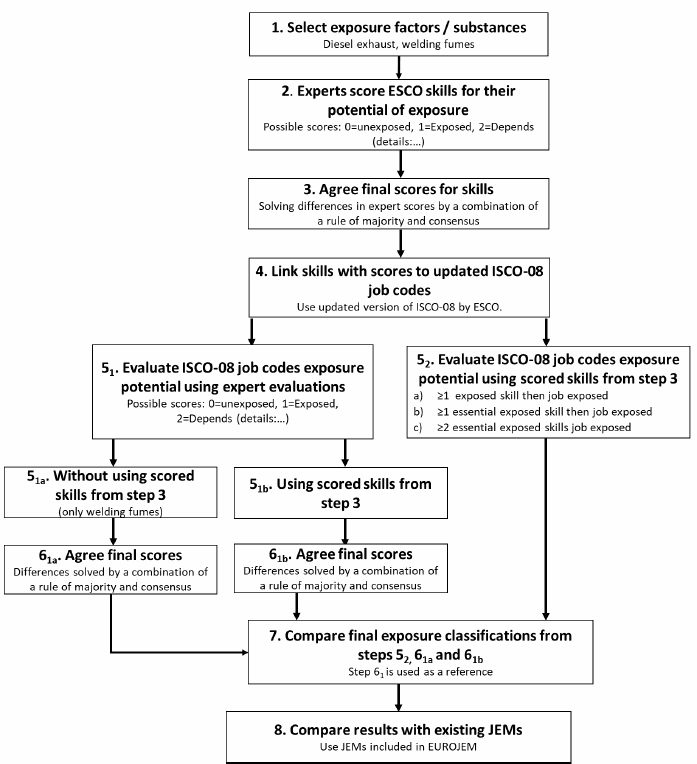Dynamic coding into for more meaningful categories for exposure assessment
This work aimed to develop more meaningful codes for exposure assessment when developing and using Job Exposure Matrices. This is performed by exploring the usefulness of two newly developed classifications by the European Commission:
- A classification that identifies and categorises the skills and competences that are relevant for the occupations of the EU labour market, the ESCO (European Skills, Competences, Qualifications and Occupations) classification and
- An updated and more detailed version of theISCO-08 (International Standard Classification of Occupations 2008 edition), the classification used to systematically identify and categorise occupations, against which the skills and competencies of a) have been mapped upon.
To achieve the above a stepwise approach has been developed which explores whether the information of skills included in ESCO can be used to identify the exposed job codes of ISCO-08. Two substances with different workplace exposure prevalences at a general population level are used as case studies: a) welding fumes and b) diesel exhaust exposure. The approach uses expert evaluations to first identify the skills/activities included in ESCO that are potentially exposed to the above agents. The developed list with the exposure assignments is then used to identify the jobs included in the updated ISCO-08 classification that are exposed to each of those agents. To allow an assessment of the usefulness of tasks in identifying exposed jobs, the results of this exercise are compared with those from exposure evaluations performed by the experts at the job categories included in the original and updated ISCO-08 coding systems blind to the underlying skills and their exposure status. The usefulness of the two new classifications on developing more meaningful job codes for exposure assessment is explored by their ability to identify sub-categories of the occupations included in the original ISCO-08 classification which by other means would be considered as unexposed. In a parallel approach the possibility of reducing the burden of the involved work by using only the tasks to identify exposed jobs is also explored. This involves removing an expert evaluation step that follows the linking of the exposed skills to the jobs and which intends to remove any arbitrary and inappropriate (i.e. non-exposed) entries.
Data analysis is performed using standard method agreement statistics including absolute proportions of agreement and weighted kappa coefficients.

Figure 1: Flow chart describing the process for evaluating the potential for improving for improving coding systems for Job exposure matrices.
All steps of the approach were implemented for welding fumes whereas for diesel exhaust only the evaluations using the ESCO classification system have been completed and are presented in the present deliverable. The results obtained thus far suggest that the newly classification systems may have the potential of contributing to the development of more meaningful codes for exposure assessment using JEM in general population studies. Some limitations of the system including the lack of information on skills required by the traditional 1-4-digit job codes included in the original ISCO classification and high labour requirements for developing the classifications are highlighted. However, since differences in the prevalence of exposure among job categories are important, the results of the evaluations for diesel exhaust will also be needed to draw more appropriate conclusions. Once obtained, the combined analyses results will be used to develop relevant lessons learned material with the results being communicated further through publication in the peer reviewed literature.
More details can be found in the document attached.
1.0
-
Health scientists
-
Report